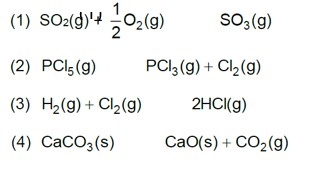For the reaction : N2(g) + 3H2(g) ? 2NH3(g)
Equilibrium constant Kc =
Some reactions are written below in Column I and their equilibrium constants in terms of Kc are written in Column II. Match the following reactions with the corresponding equilibrium constant.
Column I (Reaction)
Column II (Equilibrium constant)
(i) 2N2(g) + 6H2(g)
⇌ 4NH3(g)
(a) 2Kc
(ii) 2NH3(g)
⇌N2(g) + 3H2(g)
(b) Kc
(iii) N2(g) + 2H2(g)
⇌
NH3(g)
(c)
(d) K2c
For the reaction : N2(g) + 3H2(g) ? 2NH3(g)
Equilibrium constant Kc =
Some reactions are written below in Column I and their equilibrium constants in terms of Kc are written in Column II. Match the following reactions with the corresponding equilibrium constant.
|
Column I (Reaction) |
Column II (Equilibrium constant) |
|
(i) 2N2(g) + 6H2(g) ⇌ 4NH3(g) |
(a) 2Kc |
|
(ii) 2NH3(g) ⇌N2(g) + 3H2(g) |
(b) Kc |
|
(iii) N2(g) + 2H2(g) ⇌ NH3(g) |
(c) |
|
|
(d) K2c |
-
1 Answer
-
This is a Matching Type Questions as classified in NCERT Exemplar
Ans: (i) → (d); (ii) → (c); (iii) → (b)
Similar Questions for you
0.01 M NaOH,
M = 1 * 10-2

pOH = 2
pH = 2
Kp = Kc (RT)Dng
36 * 10–2 = Kc (0.0821 * 300)–1
Kc = 0.36 * 0.0821 * 300 = 8.86 » 9
A(g) ->B(g) + (g)
Initial moles n 0 0
Eqb. moles n(1 – a) na
total moles =
Eqb. pressure
On increasing pressure, equilibrium moves in that direction where number of gaseous moles decreases.
Taking an Exam? Selecting a College?
Get authentic answers from experts, students and alumni that you won't find anywhere else
Sign Up on ShikshaOn Shiksha, get access to
- 65k Colleges
- 1.2k Exams
- 679k Reviews
- 1800k Answers


